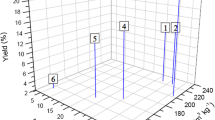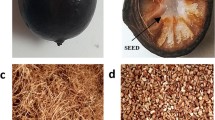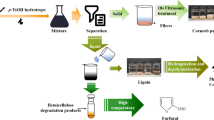Abstract
A two-step process is evaluated to separate the hexose component in wet milling corn fibers from the pentose component for production of value-added products. Corn fibers were first pretreated with hot water at 121°C for 1 h followed by glucoamylase hydrolysis to remove starch. The remaining solid was then treated with hot water at 140–170°C followed by an enzymatic hydrolysis to further separate the hexose and pentose components. After the second pretreatment, the enzymatic digestibility of cellulose was much better than that of arabinoxylan. As a result, up to 90% arabinoxylan in corn fibers was retained in a solid form after the enzyme hydrolysis, while most of the hexose components were removed.
Similar content being viewed by others
Avoid common mistakes on your manuscript.
Introduction
Corn fiber is an abundant and low-value byproduct of corn processing (wet milling, dry grind, dry milling, and modified dry grind), with an annual production of 4–5 million tons for wet milling alone at a price of about $60 per US ton (Raiagopalan et al. 2005). The utilization of corn fibers is crucial to the profitability and sustainability of a commercial corn processing operation.
Destarched corn fiber contains about 70% arabinoxylan (Doner and Hicks 1997) and is hence a good source for the production of xylooligosaccharides and other soluble dietary fibers. Soluble dietary fibers help to suppress blood cholesterol levels, especially low density lipoprotein-cholesterol, by binding to bile acids, which contain cholesterol, in the gastrointestinal tract and carrying them out of the body as waste (Woo and Kim 2005).
Strong alkalines are used to extract hemicellulose, mainly composed of arabinoxylan, from corn fibers for possible uses as corn fiber gum, non-toxic adhesives, thickeners, emulsifiers, stabilizers, film formers and paper additives (Doner and Hicks 1997; Hespell 1998). Conversion of carbohydrates in corn fibers to fermentable monomeric sugars, such as glucose and xylose, has also been carried out (Saha et al. 1998; Saha et al. 1999; Schell et al. 2004; Mosier et al. 2005). A few recent researches have explored means to produce xylooligosaccharides from biomass, including corn stover and corn cobs (Yang et al. 2006; Zhu et al. 2006). There has been no research effort dedicated to the production of xylooligosaccharides or soluble dietary fibers from corn fibers into forms for human consumption, such as nutraceuticals, functional foods, or functional food ingredients.
The objective of this research was to develop a corn fiber defractionation method for enriching arabinoxylan for the production of xylooligosaccharides or other soluble dietary fibers from the pentose portion in corn fibers.
Materials and methods
Destarching of corn fibers
Corn fibers containing up to 60% moisture (wet basis) were provided by Tate & Lyle (Decatur, IL). For improving storage stability and better handling (weighing and grinding), the fibers were dried at 105°C to a constant weight. They were then ground and sieved through a #20 mesh. Dry corn fibers, 20 g, were mixed with 80 ml sodium acetate buffer (50 mM, pH 4.5) and autoclaved at 121°C for 1 h. After cooling to 55°C, 2 ml G-ZYME 480 ethanol solution (Genencor International, Rochester, NY) was added and the mixture was shaken at 250 rpm for 16 h. After centrifugation at 6,900g for 15 min, the supernatant was discarded. The precipitate was washed with 100 ml ethanol and then centrifuged. After removing the supernatant, the precipitate was washed with ∼100 ml deionized H2O and centrifuged again at 6,900g for 15 min. Starch content in corn fiber was measured.
Pretreatment and enzymatic hydrolysis of destarched corn fiber
Destarched corn fibers were subjected to a second pretreatment under 9 different conditions (Table 1). The pretreatment was conducted with stainless steel tubular reactors (2.5 cm OD × 17.5 cm length) with a working volume of 50 ml. A SBL-2D fluidized sand bath with a TC-8D temperature controller was used to heat the reactors. Corn fiber slurry was loaded into the reactors that were submerged in the fluidized sand bath and heated to a target temperature (Table 1). Xylanase digestion of destarched corn fiber was performed in an Aquatherm water bath shaker at 40°C for 48 h. Enzeco Xylanase AN900 (900,000 BXU/gram) was provided by Enzyme Development Corporation (New York, NY), which also has glucoamylase and cellulase activity and can breakdown various complex carbohydrates. The enzyme was used at a ratio of 2 ml enzyme/100 g destarched corn fibers (dry wt).
Scanning electron microscopy
The corn fiber samples before and after a pretreatment were examined with scanning electron micrographs to observe morphology changes.
Sugar analysis
The supernatant from samples taken during the enzymatic hydrolysis was analyzed to determine the concentration of monomeric sugars and oligomers. Glucose and xylose concentrations were analyzed by HPLC using a Bio-Rad HPX-87P column (30 × 4.6 mm) at 85°C and a refractive index detector. The mobile phase was ultrapure water (18.1 MΩ cm) at 0.6 ml/min. For oligomer analysis, the supernatant (0.4 ml) was mixed with 0.4 ml of 4 M trifluoroacetic acid (TFA) and held at 100°C for 1 h. The samples were cooled, neutralized with NaOH (0.4 ml of 4 M) and the xylose and glucose concentrations analyzed with HLPC. The concentration of the polymeric sugars was estimated from the concentration difference of the monomeric sugars in the supernatant before and after the TFA-treatment. An anhydro correction was used (0.88 for xylose, 0.9 for glucose) in sugar quantification (Theander and Westerlund 1986).
Results and discussion
Destarch of corn fibers
The major carbohydrate components in corn fibers are starch 18 (% w/w), arabinoxylan 32 (% w/w) (xylose, 20; arabinose, 10), and cellulose 24 (% w/w) (Leathers and Gupta 1996; Leathers et al. 2006). Large number of starch granules can be observed on the surfaces of the wet milled fibers (Fig. 1A). After the destarching process, the starch content was decreased to 0.5 ± 0.1% with almost no adherent starch granules on the fiber surfaces. During the destarch process, the recalcitrant fiber structure remained intact (Fig. 1B).
Scanning electron microscopy (SEM) images of corn fibers. (A) Wet milling corn fiber without pretreatment; (B) destarched corn fiber; and (C) destarched corn fiber after pretreatment at 170°C and enzymatic hydrolysis. Corn fiber samples were dehydrated in a graded series of ethanol solutions (25, 50, 70, 95 and 100%) and dried in a CO2 critical-point drier. The dried samples were then mounted on stubs and sputter-coated with gold/palladium for 80 s by a sputter coater before taking the SEM images
Pretreatment and enzymatic hydrolysis of destarched corn fiber
The surface condition of fibers after the second pretreatment and enzymatic hydrolysis is shown in Fig. 1C. Compared to destarched samples (Fig. 1B), the recalcitrant fiber structure was totally destroyed by Enzeco Xylanase AN900. Typical yields of glucose, xylose, cellooligosaccharide (COS) and xylooligosaccharides are given in Fig. 2. The concentrations of glucose were higher than that of xylose and xylooligosaccharides in all cases. As destarched fibers were used as the substrate, all glucose in the hydrolysate must have arisen from cellulose. This indicates that the mild hot water pretreatment at 140–170°C followed by an enzymatic hydrolysis is effective in removing the hexose component in the fiber with the remaining solid residues rich in arabinoxylan.
Sugar yield during the enzymatic hydrolysis of hot water pretreated corn fibers. (A) Treatment at 160°C for 30 min; (B) treatment at 140°C for 30 min; and (C) treatment at 170°C for 30 min, all with a solid loading of 15% (w/v) in the enzymatic hydrolysis. Symbols: ■ Glucose; ▲ Xylose; ● Cellooligosaccharides; and ▼ Xylooligosaccharides
Saha and Bothast (1999) evaluated several pretreatments (hot water, alkali, and dilute acid) and enzymatic saccharification procedures for conversion of starch, cellulose, and hemicellulose in corn fibers to fermentable sugars. They also found that a hot water pretreatment (121°C, 1 h) facilitated the enzymatic saccharification of starch and cellulose but not hemicellulose (Saha et al. 1999; Saha 2003). Our results confirmed their observations. Hot water pretreatments at <160°C made cellulose easier to be hydrolyzed than corn fiber hemicellulose, even though the enzyme (AN900) used has strong xylanse activity. The corn fiber hemicelluloses, mostly branched arabinoxylans, are highly cross-linked by diferulic bridges, which may be responsible for their high resistance to enzymatic hydrolysis (Saulnier et al. 1995; Saha 2003). The use of enzyme preparation AN900 may not be a best choice since it has a high xylanase activity. A further improvement of the two-step process tested in this study will be to combine the two hexose separation steps into one with a hot water pretreatment followed by a glucoamylase and cellulase simultaneous enzymatic hydrolysis.
In all the 9 treatments, the glucose concentration increased during the enzymatic hydrolysis process, while the concentrations of xylose and xylooligosaccharides remained almost unchanged. Generally, a decrease in cellooligosaccharides was accompanied by an increase in glucose. The increase in glucose, however, was more pronounced than the decrease in cellooligosaccharides (Fig. 2B and C). Under those conditions, the enzyme might have solubilized cellooligosaccharides into glucose faster than did for conversion of cellulose into cellooligosaccharide. High solid/liquid ratios during enzymatic hydrolysis produced more glucose. At the lowest solid/liquid ratio (10%) (treatment E), the overall sugar yield was the lowest among all treatments.
Based on the estimated composition of corn fiber (Leathers and Gupta 1996; Leathers et al. 2006), the remaining xylose and glucose after the TFA hydrolysis were calculated (Fig. 3A). Among all the experiments, treatment G (140°C, 30 min, solid loading 15%) had the highest pentose retention (>90%) in the solid residue, with 45% remaining hexose in the solid. Since the purpose of the two-step treatment is to separate the pentose from the corn fibers for value-added products and utilize the hexose for bioethanol production, C5/C6 separation factor, a ratio of pentose to hexose in the solids, was used as another criterion in the selection of best treatment, as shown in Fig. 3B. The treatment D (160°C, 30 min, solid loading 15%) had the highest C5/C6 separation factor and a high remaining pentose of about 87%, and was hence chosen as the best treatment under the conditions tested in this study.
Xylose and glucose remaining in the solid after a 48 h enzymatic hydrolysis. (A) Remaining percentage of xylose and glucose after pretreatment and enzymatic hydrolysis; (B) C5/C6 separation factor which was defined as the ratio of pentose to hexose in the solids. The xylose percentage was estimated using 20 g xylose/100 g dry corn fiber as 100% while the base for glucose was 42 g glucose/100 g dry corn fiber (Leathers and Gupta 1996)
Conclusion
After destarching and a mild pretreatment by hot water, the cellulose in wet milling corn fibers is more susceptible to enzymatic digestion than arabinoxylan. With this method, most of the hexose components (the starch and cellulose portion) in wet milling fibers can be removed, while arabinoxylan is enriched. This finding suggests that a two-step fractionation process can be used to separate hexose components from corn fibers for biofuel production, with the remaining arabinoxylan-rich solid for the production of value-added products.
References
Doner LW, Hicks KB (1997) Isolation of hemicellulose from corn fiber by alkaline hydrogen peroxide extraction. Cereal Chem 74(2):176–181
Hespell RB (1998) Extraction and characterization of hemicellulose from corn fiber produced by corn wet-milling processes. J Agric Food Chem 46:2615–2619
Leathers TD, Gupta SC (1996) Saccharification of corn fiber using enzymes from Aureobasidium sp. Strain NRRL Y-2311-1. Appl Biochem Biotechnol 59:337–347
Leathers TD, Nunnally MS, Price NP (2006) Co-production of schizophyllan and arabinoxylan from corn fiber. Biotechnol Lett 28:623–626
Mosier NS, Hendrickson R, Brewer M et al (2005) Industrial scale-up of pH-controlled liquid hot water pretreatment of corn fiber for ethanol production. Appl Biochem Biotechnol 125:77–97
Raiagopalan S, Ponnampalam E, McCalla DSM (2005) Enhancing profitability of dry mill ethanol plants: process modeling and economics of conversion of degermed defibered corn to ethanol. Appl Biochem Biotechnol 120:37–50
Saha BC (2003) Hemicellulose bioconversion. J Ind Microbiol Biotechnol 30:279–291
Saha BC, Bothast RJ (1999) Pretreatment and enzymatic saccharification of corn fiber. Appl Biochem Biotechnol 77:65–77
Saha BC, Dien BS, Bothast RJ (1998) Fuel ethanol production from corn fiber: current status and technical prospects. Appl Biochem Biotechnol 70–72:115–125
Saulnier L, Marot C, Chanliaud E et al. (1995) Cell wall polysaccharide interactions in maize bran. Carbohydr Polym 26:279–287
Schell DJ, Riley CJ, Dowe N et al (2004) A bioethanol process development unit: initial operating experiences and results with a corn fiber feedstock. Bioresource Technol 91:179–188
Theander O, Westerlund EA (1986). Studies on dietary fiber. 3. Improved procedures for analysis of dietary fiber. J Agric Food Chem 34:330–336
Woo DH, Kim JK (2005) Method for preparing soluble dietary fiber from corn hull. US Patent 6,838,099, Jan 2005
Yang R, Zhang C, Feng H et al (2006) A kinetic study of xylan solubilization and degradation during corncob steaming. Biosyst Eng 93:375–382
Zhu Y, Kim TH, Lee YY et al (2006) Enzyme production of xylooligosaccharides from corn stover and corn cobs treated with aqueous ammonia. Appl Biochem Biotechnol 129–132:586–589
Acknowledgements
The authors would thank Tate & Lyle (Decatur, IL) for providing wet milling corn fibers. We are thankful to Dr. Penelope A. Patton at Tate & Lyle and Dr. Bruce S. Dien at the National Center for Agricultural Utilization Research (Peoria, IL) for their technical assistance in xylooligosaccharides analysis.
Author information
Authors and Affiliations
Corresponding author
Rights and permissions
About this article
Cite this article
Wang, B., Cheng, B. & Feng, H. Enriched arabinoxylan in corn fiber for value-added products. Biotechnol Lett 30, 275–279 (2008). https://doi.org/10.1007/s10529-007-9537-9
Received:
Revised:
Accepted:
Published:
Issue Date:
DOI: https://doi.org/10.1007/s10529-007-9537-9







